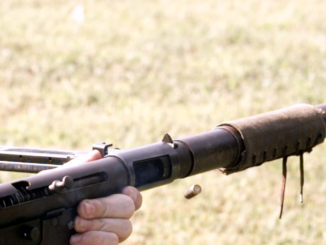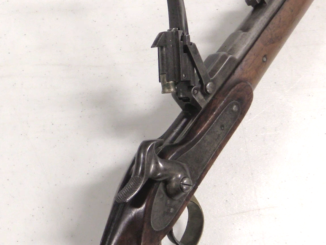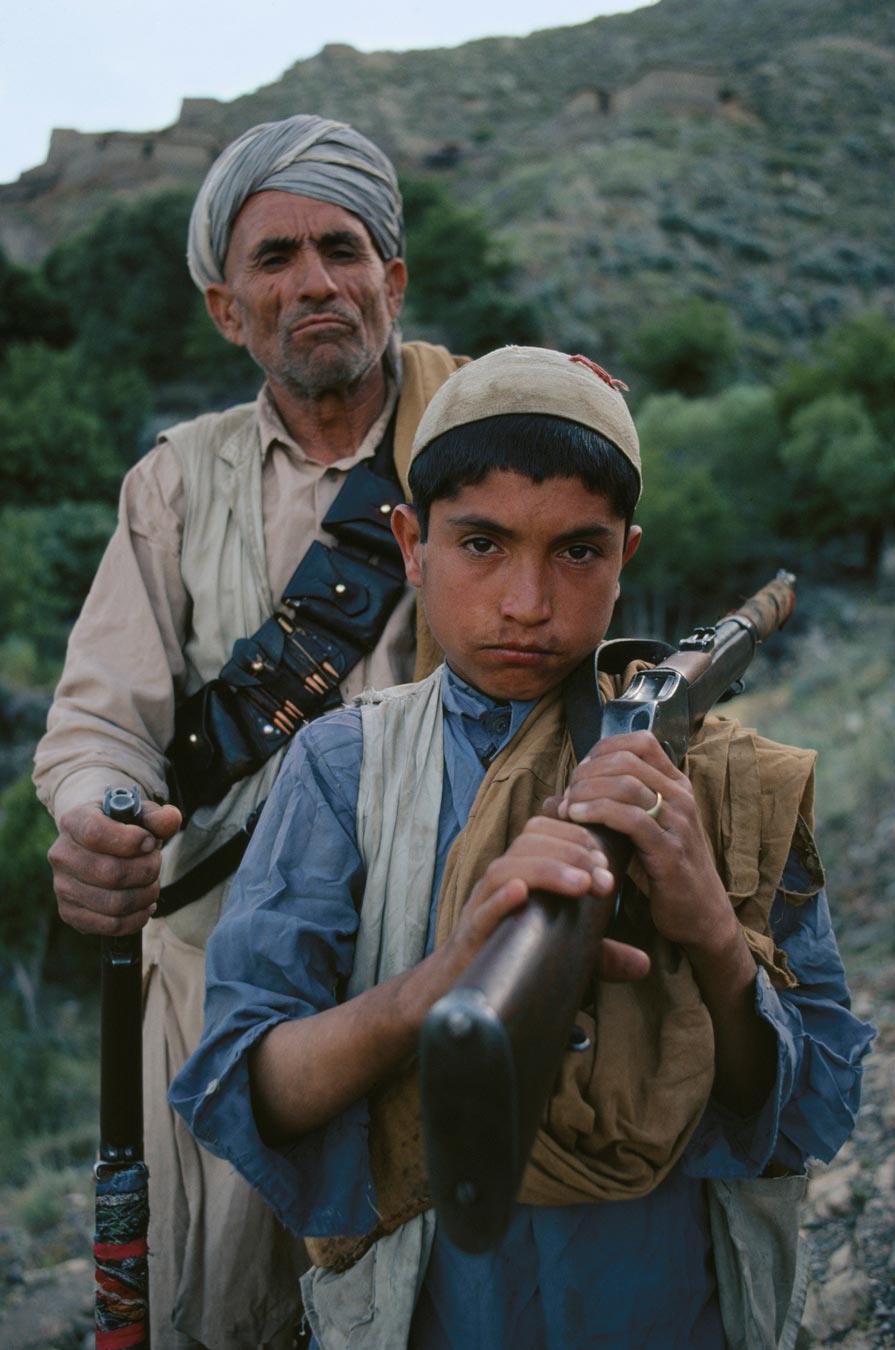The rarest variation of the Webley-Fosbery automatic revolver is the .38 ACP model. Only 341 of these were made by Webley, in an attempt to compete with the new semiautomatic pistols appearing on the market – most notably the Colt Model 1900 and Model 1902. The Colt was chambered for .38 ACP, a remarkable cartridge for its time – high velocity and semi-rimmed. Webley figured that an 8-shot Fosbery type revolver would offer the same capacity and ballistics as the new Colt, but in a revolver format familiar the the British market. The design could load cartridges individually, but also offered use of an 8-shot moon clip. Unfortunately for Webley, British legislation in 1903 hampered civilian handgun ownership and the military was not interested at all because the bore was too small. Of the 341 originally made, some were finally converted to .455 caliber models after years of not sitting unsold in Webley’s warehouse.
This model makes a notable appearance in Dashiell Hammett’s novel “The Maltese Falcon”, which quite specifically identifies it as an 8-shot, .38 caliber Webley-Fosbery. In the movie version, Humphrey Bogart mistakenly says it is an 8-shot .45, however…




Im familiar with the webly semi auto pistol.
When I was in military school at Western our Commandant had one.It impressed me as a new idea from the past?
He had quite a collection, Thompsons,MP40 Sten, Browning M2, ect. He also had a gyro jet pistol. Somthing I havent seen you do a report on. Now that is a forgotten weapon.
Druid: have a look at:
https://www.forgottenweapons.com/gyrojet-pistol-at-ria/
https://www.forgottenweapons.com/ria-gyrojet-carbine/
“(…)gyro jet pistol(…)”
For concise technical description see https://modernfirearms.net/en/handguns/handguns-en/u-s-a-semi-automatic-pistols/gyrojet-eng/
Now that Webley is making new top-breaks in India, how possible does it become to manufacture a new Fosbery?
“(…)possible does it become to manufacture a new Fosbery?”
Who would buy such weapon? What would it offer above newer MATEBA autorevolver design?
Collectors and that is about it. It would likely end up being more than most people would be willing to pay due to the intricacies involved in making it right.
Can you buy Metaba semi-auto revolvers anymore?
This is one of maybe three old handguns that could be copied and sold at a profit.
The Indians are unlikely to do it, though.
In all of Hammett’s published fiction, the WF is the only gun named by make, model, capacity and caliber. That it was, even in 1929, one of the most obscure weapons on the planet (“they don’t make them anymore”) has always indicated to me that Hammett was making a dig at both gun aficionados and readers of the drawing-room style mysteries.
Pulp stories for decades after kept having “automatic revolvers” show up. 🙂 They seemed especially common in the Doc Savage tales.
I guess other writers figure it Hammett mentioned it, then they should. It might just increase sales…
A lot of it was confusion. I have a reprint of the 1903 Sears mail-order catalog (and yes, you could mail-order firearms back then), in which the only “automatic” listed is the Colt Model 1900 in .38 ACP.
However, there are a large number of automatic revolvers listed. Without exception, they are top-break, simultaneous-ejection revolvers, mostly by Smith and Wesson, Iver Johnson, and Harrington & Richardson.
In short, back then “automatic revolver” was a common term for any revolver of the “Webley/Smith & Wesson” top-break variety.
BTW, I have read most if not all of the Doc Savage stories, and the most common handguns mentioned other than Doc’s supermachine pistols are regular revolvers and automatics. There are frequent references to a variety of “spike-nosed” automatic pistol, as in The Squeaking Goblin, which I conclude was a reference to either the Parabellum or Mauser “Broomhandle” type.
😉
cheers
eon
This revolver was doomed from birth.
Poor choice of ammunition.
The reputation of the 38th ball at that time was seriously damaged. And all sorts of new products, like 38super, this also affected.
In its original .45, it was a very successful revolver. Thanks to the automation scheme with significantly lower recoil and better accuracy than all other 44-45s.
Perhaps some simple trick, like changing the name of the cartridge as 9x23HOT, could turn the story in a different direction…
“(…)Colt was chambered for .38 ACP, a remarkable cartridge for its time(…)”
Whilst sales of such chambered Webley-Fosbery were dismal, they apparently considered cartridge itself sound, which result ind development of automatic pistol chambered for it – namely model of 1910 – see 9th image from top: https://modernfirearms.net/en/handguns/handguns-en/great-britain-semi-automatic-pistols/webley-scott-automatic-pistol-eng/
.38” sold very well in the early 1900s, as did the various 9mms and 7.62-7.63 rounds.
Later, .38” Super and .357” Magnum also sold well.
Aside from the US cavalry wish for a horse-killing .45” that led to the 1911, the idea that all serious people in the old days used .44” or .45” is a historical myth retrospectively reflecting the views of writers like Elmer Keith and Jeff Cooper.
The W-F had a brief flurry of success as a target pistol, given it offered a re-cocked single action pull that was highly useful in the rapid-fire stage of a revolver match. But it never sold in large volumes, and its terrible reliability in the trenches killed it off completely.
Ultimately, I it’s recoil energy is marginal for reliable function. I do wonder whether the .38” with its higher chamber pressure might actually be slightly less unreliable than the .455”…
There was an American copy, the Union. That would be a perfect FWs video, as almost no-one has heard of it and it’s very, very, rare.
Now I’m wondering if this revolver might have been more successful if chambered for the .38-200 cartridge. This version of the already obsolescent .38 S&W was popular with British and Canadian Law Enforcement and Military. (I have three revolvers chambered and sighted for this, one of them a S&W K Frame made for the Canadians in about 1937. It will still shoot under 2″ at 25 yards from a rest, with the right ammo.)
“(…)if this revolver might have been more successful if chambered for the .38-200 cartridge. This version of the already obsolescent .38 S&W was popular with British (…)Military.(…)”
I do not know about Canadian or Law Enforcement, but British Military did approved that cartridge in November 1930
https://sites.google.com/site/britmilammo/-380-inch-revolver/-380-inch-ball
well after Webley-Fosbey popularity already faded.
Some like Cooper have criticized this as a step down in power. In fact, the .38/200 aka .38 S&W and the .455 Webley with the 265 grain bullet had almost exactly the same muzzle energy, about 220 foot-pounds, because the .38 bullet left the muzzle at 800 feet per second vs. only about 640 for the .455.
I’d say this was more a case of the British Army realizing that their “in-house” set of revolver cartridges dating to the 1870s (the .476, .450, and .455) were no more powerful than the “short” .38 S&W of the same vintage.
If you can live with that level of power (and 200 FPE is more than enough to kill a man with a center hit), going to a lighter, more compact service pistol is just common sense.
cheers
eon
“(…)There was an American copy, the Union. That would be a perfect FWs video, as almost no-one has heard of it and it’s very, very, rare.”
Wait… are you implying https://www.youtube.com/watch?v=L7K3nfH8cK0 is not up-to-date and that particular weapon in dire need of newer video?
Nah, missed that.
Good call.
OFF-TOPIC so ignore this post if you wish.
According to https://www.overtdefense.com/2020/11/09/us-army-seeking-increased-lethality-grenade-launcher-with-new-precision-grenadier-system/
US Army Seeking Increased Lethality Grenade Launcher with New Precision Grenadier System. This weapon is supposed to be:
a man portable integrated weapon system that enables precision engagements to destroy personnel targets in defilade and in the open with increased lethality and precision compared to the legacy M203/M320 grenade launchers. The PGS provides overmatch to comparable threat grenade launchers in near peer formations in future operating environments (jungle, urban, woodland, subterranean, desert, day/night). The PGS is envisioned to consist of a weapon, a fire control, and a suite of ammunition which enables the user to engage targets in defilade/cover, hovering UAS targets, conduct door breaching, engage close combat targets, and light armored targets.
I do not keep very carefully with state of current development of U.S. weapons, so I have some basic questions relating terminology used:
When M203 grenade launcher was declared “legacy”? When M320 grenade launcher was declared “legacy”? In what way (if any) is being “legacy” related with state of being Substitute Standard for fire-arm, as applied during WWII? What does overmatch (“to provide overmatch”) mean in context of hand-held grenade-launchers?
Perhaps “legacy “ refers to a current weapon system that is outdated but difficult to replace with new technologies.
The “overmatch” gobbledygook techno babble is more difficult to discern.
To me it sounds like a retread of the failed XM26 weapon “system”, with the 25mm GL developed by Heckler and Koch. It had a “really neat” (i.e., hideously complex) “Firewire” system that was supposed to reprogram the fuze on a round as it left the muzzle, to do the things described above.
No, it never worked. But hope springs eternal when it comes to “studies”. At least the hope for funding, and somebody getting a promotion or two because their name is “attached” to the project.
Naturally, nobody ever gets demoted if the project fails.
cheers
eon
“(…)failed XM26 weapon “system”, with the 25mm GL developed by Heckler and Koch(…)”
Wait… I always think XM26 is 12 gauge under-barrel shotgun
https://modernfirearms.net/en/shotguns/u-s-a-shotguns/m26-mass-eng/
so there was another XM26?
Army Ordnance tried to “expand” the shotgun system to a 25mm GL. It was funded as a continuation of the original project, so kept the XM designation.
Look for it as Objective Individual Combat Weapon aka OICW. The final variant was a 25mm GL with a short 5.56mm carbine “underneath”. The XM number may have been changed later in the program.
cheers
eon
“Legacy” means “what we’ve been using for years because it works”. “Provides overmatch” means “better than”. This is the sort of gibberish you get when people write to impress others.
Since it’s Memorial Day I thought I’d share that at one point during World War II My Dad was was a 23 year old 2nd lieutenant flying co-pilot on C-47’s out of Naples into makeshift airfields carved into the mountains of Yugoslavia dropping off supplies and picking up wounded partisans with the US Army Air Corp’s 62nd Troop Carrier group under British command. They were stationed there shortly after Italy surrendered and at that time there was a lot of thuggery and attacks on allied servicemen in the streets. Dad was not one to be easily impressed but he said of all the people he met there his personal hero was a British Sergeant who when jumped by a mob killed all eight with eight shots from a webley Fosbury automatic revolver.
Later Dad was a serious bullseye shooter who did all his own work on slant grip high standards, Smith 52’s, and 1911’s and he felt like the webley Fosbury automatic revolver had an advantage over the 1911 in rapid fire.
I will try consistently.
The fashion for pistol cartridges of reduced caliber with nitro-powder took over a significant part of the European market at the beginning of the 20th century.
But only in those countries where there was not enough experience in using pistols for their intended purpose.
In the “antiquity” they did not think about any “stopping action”. There was no need because of the large calibers. And “lethality” was assessed by the penetrating ability.
Like, “if an inch board breaks through, then order. And if two, then it is good for service.”
And it turned out that .32ACP is quite a service cartridge. And if you add a little, then the military. 😉
Therefore, the soldiers of the French Foreign Legion, armed with the “outdated” 11 mm 1873, did not notice the difference, but the officers of the 1st World War with Mle 1892, quite.
But their opinion was not asked. And there was no one to ask.
The British, originally adherents of large pistol bullets. For the gentlemen who fired back at the natives had much to lose.
And the Philippines, China and others, have clearly demonstrated, literally, who weighs how much. But under the machine guns and they quickly ended too.
Therefore, for the next big war, the bet was made on a cheap mass pistol.
There were still games with bullets, but it didn’t help much.
The early 38 cartridge for the 1900 colt was the 38AC not ACP. The difference was in the pressure, the AC being lower. I have boxes marked as 38AC. The experts can correct if this is wrong.
Kynoch-brand boxes of the vintage were simply marked “.38 Automatic”, and listed as being “For Colt and Webley pistols and revolvers”.
They were red-and-yellow pasteboard boxes that held 25 rounds. I still have a couple unopened.
cheers
eon
“Kynoch-brand(…)”
STANDARD BALLISTICS OF KYNOCH CENTRAL-FIRE METALLIC CARTRIDGES call it just ·38 Automatic Pistol and states it launch 130 gr. Metal-covered BULLET at 1,050 Ft. per sec.
The 1903 Pistols Act did not really affect the right to keep and bear arms in Britain. That began to be eradicated by the 1920 Firearms Act and continues to this day..
The Pistols Act made it illegal to sell a pistol to a child or a drunk. There was not much more to it than that. I think if one wanted to carry a pistol about it was necessary to purchase a Gun Licence. These were sold at every post office for ten shillings, so again, not an onerous requirement.
I imagine if the Webley-Fosberry did not sell well, it may have been down to its price more than any other consideration. It must have cost more than a regular revolver, or indeed one of those new-fangled automatic pistols.
Also, that large cylinder makes it very wide in comparison to the automatics then on the market. I prefer my S&W Shield 9mm to my S&W .38 5-shot snub nose for concealed carry for that reason, and the 5 round cylinder is of course not as wide as that 8 round one.
“(…)it very wide in comparison to the automatics then on the market(…)”
Also – unlike normal revolver – it was unfamiliar for potential customers and from practical usage view-point joined draw-backs of then available automatics (if you have dud cartridge pulling trigger again is not enough) and revolvers (fat due to presence of cylinder)
Following the results of the WW1, the Supply Office(?) came to the conclusion that the army needed a new pistol.
Moreover, it must be massive. Since with a low saturation of the army with portable weapons, in the conditions of a trench, it is desirable to have a pistol for almost everyone who participates in actions.
But in the conditions of total absorption of funds by the fleet, there is a shortage of them.
Enfield was faced with a rather ambitious task.
The main problem was not even the cost of the pistols themselves. But the cost of training their users. Since the great recoil of the old cartridge required a longer and more costly training course.
The conclusion was obvious, reduce recoil.
This can be done in a simple way (for known reasons) only by reducing the mass of the bullet.
But this results in an unsatisfactory stop effect.
A new revolving cartridge was developed, in which the weak frontal action of the bullet was partially compensated by its lateral action when overturning in the body.
After testing, the “lethality” of the new cartridge was recognized, if not “good”, then “enough”.
But reality (as usual) made adjustments.
When it turned out in WW2 that the industry could not meet the needs of wartime, an order for cartridges was placed in the United States.
But it turned out that the production equipment did not allow stamping bullets of the required length. Therefore, the cartridges were loaded with bullets similar to the 38SW long.
Accordingly, the effect of these bullets was not much different from the Philippine experience.
And so the funny degenerate appeared.
on the cultural impact side, “automatic revolvers” in .38 cal are mentioned in at least two of John Dickson Carr’s locked room mysteries. One such novel is “The Judas Window”, widely considered to be his best. Although not identified as WF, he calls them “modern automatic revolvers” in The Three Coffins. these stories were written in the 1920s-1930s though. Maybe he just didn’t know much about guns.